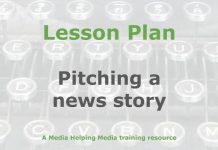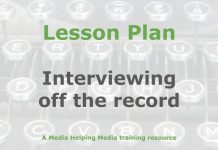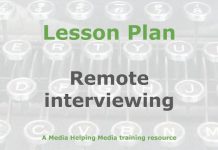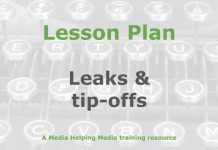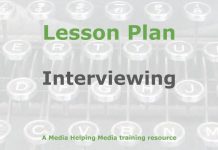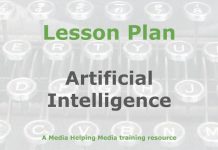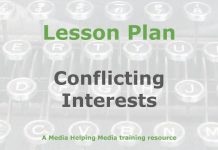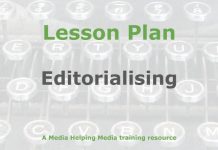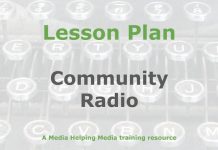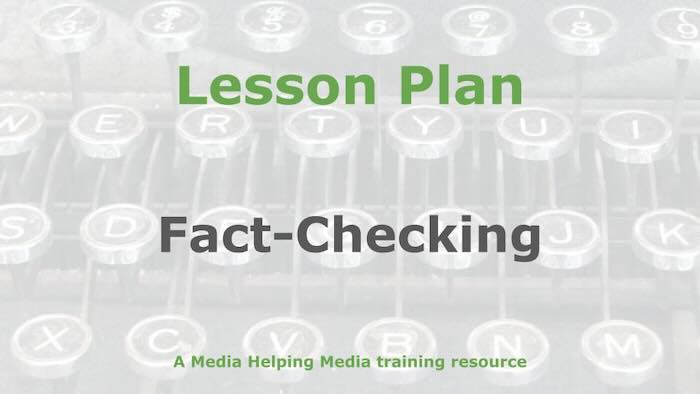 This lesson plan is designed to teach students how to fact-check then add context so that the information produced in a news report is accurate and complete.
This lesson plan is designed to teach students how to fact-check then add context so that the information produced in a news report is accurate and complete.
Its based on the article Fact-checking and adding context which is published on Media Helping Media. We recommend journalism trainers read the article before adapting this lesson plan to meet local needs..
Learning objective
Students will evaluate the accuracy of information in a news report by identifying factual errors and adding relevant context. They will demonstrate the ability to cross-reference sources and integrate background information to ensure comprehensive reporting.
- Student-facing objective: By the end of this lesson the student will be able to check a news report for mistakes and add important details to make it more complete and accurate.
- Standards: To teach students how to fact-check then add context so that the information produced in a news report is accurate and complete.
Learning activities
Warm-up
Display a short, simple news headline on the board. Ask students to jot down what they know about the topic and any questions they have. After a few minutes, have students share their thoughts with a partner. Then, select a few students to share their ideas with the class. Record key points and questions on the board. This primes students to think critically about information and context, setting the stage for fact-checking and adding context.
Direct instruction
- Introduce fact-checking: Present a brief news article with intentional factual errors. Explain the importance of verifying information. Discuss common sources for fact-checking, such as official reports, expert interviews, and reliable databases. Emphasise cross-referencing multiple sources to confirm accuracy.
- Demonstrate contextualisation: Use the same article. Highlight a fact and discuss its context. Explain how context affects understanding. Provide an example: a statistic about unemployment rates. Discuss how economic conditions, policy changes, and historical trends provide context. Encourage students to think about what additional information might be needed to fully understand the fact.
- Model the process: Walk through a step-by-step process of fact-checking and adding context using a real-world example. Start with identifying a claim in the article. Demonstrate how to verify it using a trusted source. Then show how to add context by integrating background information. Use placeholders for solution steps. Conclude by discussing how these steps lead to a more accurate and comprehensive news report.
Guided practice
Think, Pair, Share: Distribute a short news article with factual errors and missing context.
- Think: Ask students to individually read the article and identify any factual errors or missing context.
- Pair: Have students pair up to discuss their findings. Encourage them to compare notes and discuss any discrepancies.
- Share: Facilitate a class discussion where pairs share their findings. Record key points on the board. Encourage students to explain how they identified errors and what context they believe is missing.
- Cross-reference: Guide students to use reliable sources to verify the facts they identified as errors. Provide access to computers or printed materials.
- Add context: Instruct students to add relevant context to the article based on their research. Encourage them to consider historical, economic, or social factors.
Independent practice
- Provide students with a new short news article containing factual errors and lacking context.
- Instruct students to independently identify and correct factual errors using reliable sources.
- Direct students to add relevant context to the article, considering historical, economic, or social factors.
- Encourage students to reflect on how their corrections and added context improve the article’s accuracy and completeness.
Assignment
Ask students to answer these questions:
- What is one method you used to verify a fact in today’s lesson?
- How did adding context change your understanding of the news article?
- What’s one question you still have from today’s lesson?
Here are some suggested answers:
- Suggested answer to Question 1: Cross-referencing with a reliable database or official report.
- Suggested answer to Question 2: Adding context provided a deeper understanding of the issue by considering historical or economic factors.
Teacher resources
Differentiation guide
- Advanced learners: Encourage deeper analysis by having them explore multiple perspectives on a fact. Assign tasks to evaluate the credibility of different sources. Challenge them to identify potential biases in the information and context provided.
- Striving learners: Simplify tasks by providing a checklist for fact-checking steps. Pair them with peers for collaborative work. Offer guided questions to help them identify key facts and context. Use visual aids to illustrate the process of adding context.
- Background reading: We recommend you read the article Fact-checking and adding context before adapting this lesson plan.
Notable definitions
- Fact-checking: The process of verifying the accuracy of information by cross-referencing multiple reliable sources to confirm its truthfulness.
- Contextualisation: Adding background information to a fact or statement to enhance understanding by considering historical, economic, or social factors.
- Cross-referencing: Comparing information from different sources to ensure consistency and accuracy, often used in the process of fact-checking.
Required materials
- Short news articles with intentional factual errors
- Access to computers or printed materials for research
- Whiteboard and markers for recording key points
- Handouts with checklists for fact-checking steps
- Visual aids illustrating the process of adding context
Lesson summary
- Warm-up
- Direct instruction
- Guided practice
- Independent practice
- Assignment
The free teaching tools at the Khan Academy were used in the production of this lesson plan.
Related article
